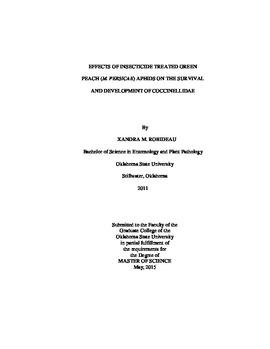| dc.contributor.advisor | Giles, Kris L. | |
| dc.contributor.advisor | Royer, Tom A. | |
| dc.contributor.author | Robideau, Alexandra M. | |
| dc.date.accessioned | 2016-04-15T21:49:38Z | |
| dc.date.available | 2016-04-15T21:49:38Z | |
| dc.date.issued | 2015-05-01 | |
| dc.identifier.uri | https://hdl.handle.net/11244/33448 | |
| dc.description.abstract | Annual canola yield losses have been significant in Oklahoma due to high insect pressure, and insecticide treatments are required multiple times throughout the growing season to produce a profitable crop. Synthetic pyrethroids are the most commonly used foliar insecticides for management of insect pests in canola, but they have been shown to have negative effect on both natural enemies and pollinators. Aphids in crop systems are a primary source of prey for lady beetles, making them beneficial in fields with frequent aphid outbreaks (Kring et al. 1985, Rice and Wilde 1988, Elliott et al. 1996, Jones 2001). This study will explore the effects of insecticide (flonicamid and sulfoxaflor)-treated aphids on ladybeetle development and survival.Larval development time, adult body size, and male:female ratios from my trials indicate that flonicamid could be a valuable tool in fields where Coccinellids provide some level of biological control of aphids. Flonicamid allows for the possibility of longer-term lady beetle survivorship, where other pesticides such as synthetic pyrethroids do not. Conversely, these studies also indicates that sulfoxaflor treated aphids have a toxic effect on Coccinellids and may be a poor choice for use in similar fields. Consumption of sulfoxaflor treated aphids resulted in longer development times, which expose lady beetle larvae to other mortality effects, such as predation and further pesticide sprays. Sulfoxaflor treatments also resulted in reduced body size in adult lady beetles, which would likely decrease fecundity and ultimately reduce population size in the agricultural landscape. The fact that there were no surviving female C. septempunctata feeding on sulfoxaflor-treated aphids, and that male H. convergens were of smaller body sizes, indicates that sulfoxaflor-treated fields could be an ecological sink for these predator species. | |
| dc.format | application/pdf | |
| dc.language | en_US | |
| dc.publisher | Oklahoma State University | |
| dc.rights | Copyright is held by the author who has granted the Oklahoma State University Library the non-exclusive right to share this material in its institutional repository. Contact Digital Library Services at lib-dls@okstate.edu or 405-744-9161 for the permission policy on the use, reproduction or distribution of this material. | |
| dc.title | Effects of Insecticide Treated Green Peach (M. Persicae) Aphids on the Survival and Development of Coccinellidae | |
| dc.type | text | |
| dc.contributor.committeeMember | Belden, Jason B. | |
| osu.filename | Robideau_okstate_0664M_13744.pdf | |
| osu.accesstype | Open Access | |
| dc.description.department | Entomology (PhD) | |
| dc.type.genre | Thesis | |
